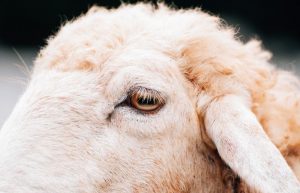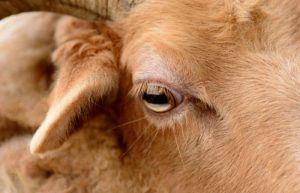
How Well Can Sheep See?
Understanding how animal senses compare to your own can be a fun way to learn about different species and how they function. Sheep are one animal of common interest as small livestock animals who have been the center of study for both emotional, physiological, and psychological research. You may be wondering how sheep use their senses to avoid predators and stay together in a flock.
What can sheep see? Sheep have a complex visual system that affects their vision in the following ways:
-
Sheep can see over 300° around themselves due to monocular vision
- Sheep have blind spots where they cannot see directly in front of or directly behind themselves
- Sheep have horrible depth perception due to their rectangular pupils
- Sheep can only see at a distance of around 20 feet
- Sheep can rotate their eyes upward 50° to have a clear view of their surroundings even when their head is down to graze
- Sheep can see in color, noticing colors like red, green, yellow, black, brown, and white
As prey animals, sheep rely heavily on their senses to keep themselves safe from danger. While sheep may be lacking in eyesight compared to most predatory animals, they have a keen sense of hearing and smell that makes up for it. To learn more about how well sheep can see, keep reading!
Sheep Have a Peripheral Vision Range of Over 300°
One aspect that determines how the visual system in sheep function is the fact that sheep are prey animals. By nature, most prey animals have similar visual systems that are designed to be alert and focused on as wide a view of the surroundings as possible. This ability comes mostly from the placement of the eyes on the sheep’s head.
Sheep have monocular vision, meaning that their eyes are on the side of their head. Just about every prey animal has monocular vision while predators tend to have binocular vision, where the eyes are on the front of the head with poor a peripheral range. Monocular vision on the other hand, enables prey animals, like sheep, to see in peripheral ranges of over 300°.
This means that sheep can see almost completely around themselves. This enables them to be completely aware of their surroundings, being able to keep an eye on the other sheep in their flock while also scanning for danger in the surrounding area.
Sheep Cannot See Directly In Front Of or Behind Themselves
While sheep can see over 300° around, there are certain areas that a sheep will not be able to see. Sheep have blind spots directly in front of them and directly behind them where they cannot see a thing. The good news is all the sheep has to do is turn its head slightly to then be able to see in those blind spots. However, it’s important to keep the sheep’s blind spots in mind if you ever approach a sheep.
Approaching a sheep directly from behind can cause it to become startled and run away, which can be annoying if you’re trying to catch it. For this reason, always talk calmly as you approach a sheep so they know you are there. Also, refrain from moving quickly directly in front of a sheep, even if you are going to pet them, as they cannot see directly in front of themselves. Petting them on the head may startle them if they are not aware of what you are doing.
Always stay to the side of a sheep rather than in front of one to avoid getting run over in the event the sheep would get startled, since they won’t see you standing directly in front of them.
Sheep Have Poor Depth Perception
If you’ve ever looked closely at a sheep’s eye, you’ve probably noticed that the pupil is rectangular. This also goes for animals like horses, cattle, goats, and even toads, as these animals are all prey animals. Prey animals tend to have horizontal rectangular pupils to enhance their peripheral range of vision while predators tend to have circular pupils or vertical slit pupils that limit their peripheral vision.
While rectangular pupils enable sheep to better grasp what’s happening peripherally, it also contributes to poor depth perception. The more horizontal a pupil is, the worst the animal is able to perceive distance and speed.
On the other hand, the more vertically narrow a pupil is, the more the animal is able to perceive distance and speed. This is what makes cats such great hunters and chasers; their narrow pupils enable them to easily gage the speed and distance at which their prey is traveling at.
Sheep Can Only See About 20 Feet Away
Besides having poor depth perception, sheep also can’t see that far. While there haven’t been many studies done on exactly how far sheep can see, there have been studies done on animals with similar visual systems, like horses. Horses are said to see in 20/30 vision, which means they can see about 20 feet away. By comparing the visual system makeup of horses and sheep, you could say that sheep probably are in the same boat.
To give you perspective, if you’re a human with good eyesight, you can probably see objects clearly that are 60 feet away, and you may be able to clearly read letters and symbols that are as far as 20 feet away. Sheep on the other hand, will have a hard time making out anything that is over 20 feet away from them.
Sheep Can Rotate Their Eyes Upwards About 50°
Try this: keep your head facing straight but rotate your eyes upward to look at the sky or ceiling. After a while it starts to hurt, doesn’t it? Well, sheep have the ability to rotate their eyes 50° upwards and hold it for long periods to time. This comes in handy while grazing; the sheep’s head is down but they need to be able to stay focused on what’s going on around them.
The sheep will graze with their head down but rotate their eyes upward so they can continue to scan their surroundings. Sheep graze for as long as seven hours a day; imagine holding your eyes like this for seven hours! Most herbivores that rely mostly on grazing have this same ability.
Sheep Can See in Color
 There’s a myth out there that animals can’t see in color. While some animals may not be able to see color as vibrantly as humans, most can in fact see in color. The way scientists know this is they examine the structure of the eye. Humans can numerous cones in their retina that enable them to see in a wide range of vibrant colors.
There’s a myth out there that animals can’t see in color. While some animals may not be able to see color as vibrantly as humans, most can in fact see in color. The way scientists know this is they examine the structure of the eye. Humans can numerous cones in their retina that enable them to see in a wide range of vibrant colors.
Sheep also have cones in their retinas, just not as many as humans. This means they can probably see a limited range of color. Based on the cones they do have, sheep can probably see colors like red, green, yellow, brown, black, and white. While this may not seem like much, it can make it easier for sheep to differentiate when something is out of the ordinary.
Do Sheep Have Good Vision?
With all this said, hopefully you can now determine whether or not sheep have good vision. Compared to humans and predatory animals, a sheep’s vision would be considered poor. While monocular vision does give them the ability to see almost completely around themselves, the inability to see distances and perceive depths does not help sheep much when it comes to surviving.
With such bad eyesight, it may not seem like sheep have a lot going for them; there are ways, however, that sheep can protect themselves from danger. To learn more, read my article How Do Sheep Protect Themselves? Essential Guide.
Other Senses That Sheep Use
Fortunately, sheep do have other highly capable senses that serve them better when it comes to sensing danger and staying safe. Sheep rely heavily on sounds and smells to determine whether there may be a threat. They have enhanced scent and hearing abilities that rival those of their predatory counterparts.
Sheep Can Rotate Their Ears in Different Directions to Pick Up More Sounds
Sheep can rotate their ears completely 180° to pick up sounds all around them. They can even rotate their ears in different directions from one another, enabling them to stay alert and notice any sounds that may be out of the ordinary. By doing this, sounds reach each ear at different times, amplifying the sounds and helping the sheep recognize any sound that ins’t usual.
Sheep are especially wary of loud random noises. Their first instinct upon hearing such sound would be to run away in the opposite direction that the sound came from. By staying together in a flock and all using their keen sense of hearing, sheep should be able to easily pick up on danger approaching.
Sheep Can Hear Sounds Over 2.5 Miles (4 km) Away
Sheep have such good hearing that they can recognize sounds up to 2.5 miles (4 km) away. This means that sheep can easily track sounds as approaching the flock or traveling away from the flock. Sheep can also recognize sounds; they use this most often when trying to communicate with each other.
Ewes will locate and recognize their lambs by their sounds. Sheep within a flock will also use calls and sounds to signal where each member is. To learn more about how sheep communicate with each other, check out my article Why Sheep Bleat: Essential Behavior Guide.
Sheep Often Face Into the Wind to Gather Smells
Another way sheep are able to locate each other and potential danger is through scent. Sheep will use scent to locate their lambs and rams will use it to find ewes in heat. Sheep are as wary of new scents as they are of unfamiliar noises. If they catch wind of an unfamiliar scent or a smell that could be a predators, sheep will immediately go into flight mode.
To gather different smells and scents, sheep will often face into the wind. The wind can carry scent from miles off, giving sheep plenty of warning of approaching danger.
Sheep Are Able to Differentiate Smells From One Another
Did you know that sheep can differentiate smells from one another? Sheep can smell plants and know which ones they should eat and which ones they shouldn’t eat. They can also recognize different feeds or hay compared to what they usually eat. Sheep are also able to recognize the smell of water and use their scent to find a water source to drink from.
A sheep’s ability to see greatly affects their behavior and whether they find you as friend or foe. To learn more about sheep behavior, check out my article Sheep Behavior: Ultimate Sheep Behavior Guide.
